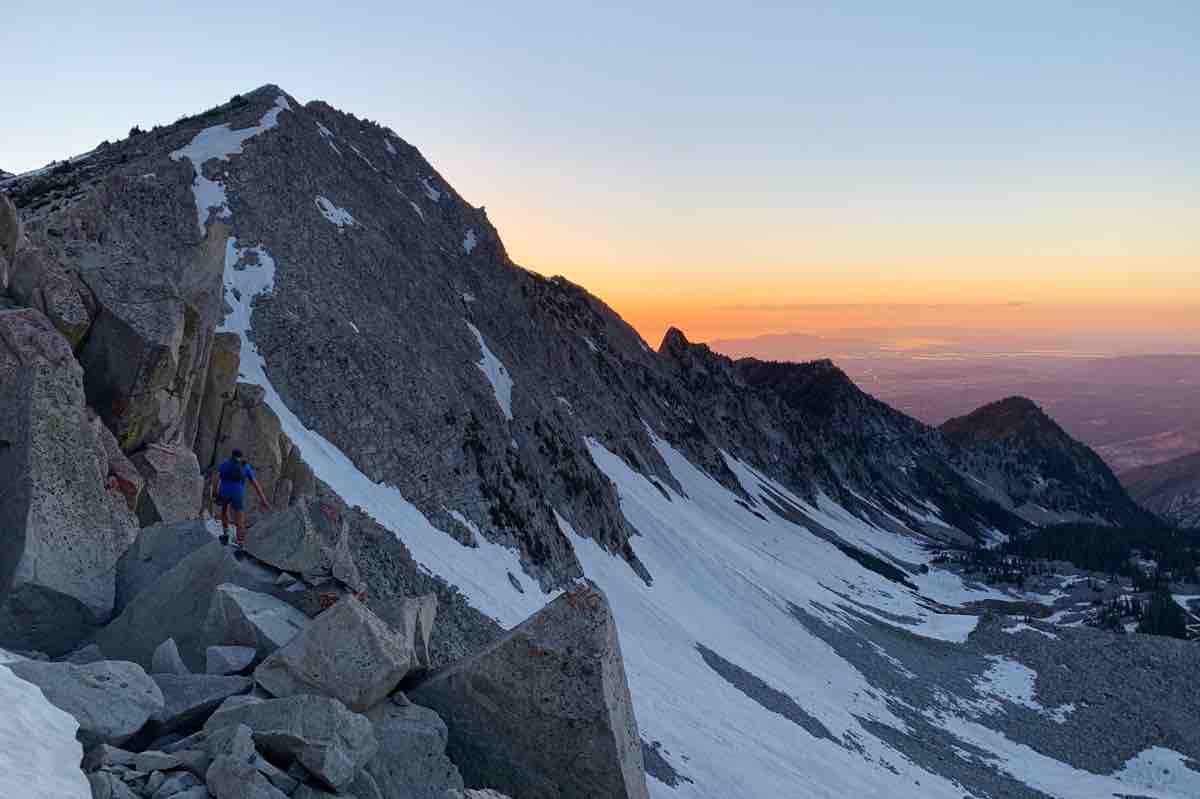We crest the final summit block of Lone Peak at last light. A ridgeline, peppered with chunky granite blocks, drops down to the north to a prominent notch marking the location of our descent route to Bells Canyon. Kyle Richardson and I had been observing this steep, eastern-facing couloir from across the way with growing trepidation. We knew nightfall would yield harder snow, making for a more complex and potentially hazardous plunge into the canyon.
We sat exhausted on top of the peak, heavily depleted from hours of exposure high above treeline. We’d encountered more rock hopping than we’d bargained for in the Wasatch Mountains’ empire of talus. The tedium and focus required to navigate such terrain combined with stifling temperatures had worn us thin. We clicked on our headlamps and peered down the ridge, unable to distinguish much of what lay ahead. All we knew was that a quick exit seemed unlikely, and that the comforts of a shower, food, and sleep would have to wait.
We’d set off at around 4 a.m. that morning to tackle the Wasatch Ultimate Linkup (WURL), the brainchild of mountain-wanderer extraordinaire, Jared Campbell. The route is an aesthetic horseshoe circumnavigation of the ridge above Little Cottonwood Canyon in Utah.
We woke at 3 a.m. to the congenial smell of breakfast tacos and coffee that our dear friend Roch Horton was preparing in the kitchen. With barely enough time to drain our first cup, and eyes still half shut, we bushwhacked our way up Ferguson Canyon toward the summit of Broad Fork Twin, which we reached at sunrise. We’d mistakenly skipped filling up with water at the lower section of the creek, forcing us to desperately stuff our bottles with snow as we gained the ridge. Little did we know then that this was a precursor of things to come. Temperatures in the city neared 100 degrees Fahrenheit that day, and wouldn’t get much cooler in the alpine. We knew conditions wouldn’t be optimal for moving quickly, especially self-supported, but we figured our small window of opportunity to complete the route would still be worth the effort.
We skipped our way across Dromedary, and Monte Cristo, to Mount Superior, enjoying the wild exposure, and nursing the last bit of our snowmelt. We mingled with mountain goats among the wildflowers on the dusty trail section of the upper curve of the horseshoe. We reached the halfway point heavily parched, transitioning from pleasant quartzite rock to the sharp limestone of Devil’s Castle. After a few more bumbly hours, we arrived at the only resupply point on the route, the restaurant at the top of the Snowbird Aerial Tram. A planned 15-minute stop quickly morphed into an hour of doodling in the shade, eating cookies, and sipping ice-cold soda.
Our woes with the heat intensified after the tram. Our stops became longer and more frequent as we patiently waited for tiny trickles of melt to fill our bottles. Delirious and weary, we made snow cones topped with skittles, constantly trying to remind ourselves of how fortunate we were to be surrounded by such beauty, while also cursing the talus.
We were treated to a stunning moonrise, and the city soaked in fiery orange light upon reaching the final summit. I immediately texted Catherine Mataisz (Roch’s wife): “Lone Peak summit. See ya soon.” She texted back: “Great! Hector’s burritos and cold drinks waiting for you at the trailhead!”
We could just about smell the delicious end as we picked our way down the serrated ridge in the dark. We reached the notch, and skippered down the upper section of the couloir, laced with loose, marble-sized scree. I prodded the snow with my finger tips. It felt hard, rock hard. I grabbed a rock as a makeshift ice axe and attempted to kick a few steps, but didn’t even make a dent. The prospect of a safe slide seemed slim as we couldn’t properly gauge the runout with the limited view from our headlamps. We proceeded to downclimb the friable rock to the side of the snow, peering down wide gaps that surely lead to Middle Earth. We encountered an impasse with snow too hard and steep to one side, choked with avi debris, and rock seemingly too challenging to the other side. We sat there for a moment, both nauseous from exhaustion, tired of trying, and wishing we could somehow teleport to the end, to comfort, to Roch and Catherine, and to burritos. While it was hard to appreciate then, these are the moments that make traveling in complex mountain terrain so compelling. These are the moments that bring out the best in us, where we help and support each other, rise above the discomfort, and find a solution to get home safely. And, before long (well, actually several hours of tedious tinkering), we finally made it back down to the trailhead to enjoy a little Mexican spice with friends. We were beat, but content and ready for a good night’s sleep.
Call for Comments (from Meghan)
Can you share your own story of trying day in challenging terrain that felt worthwhile later on?







